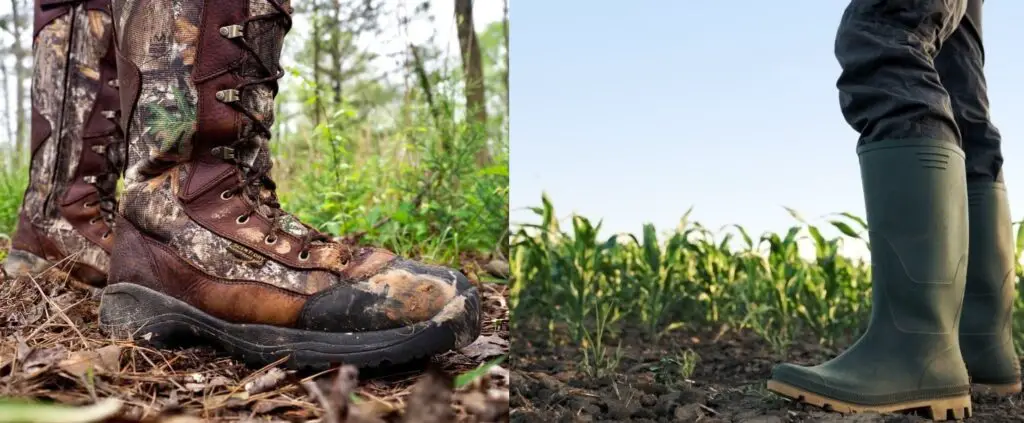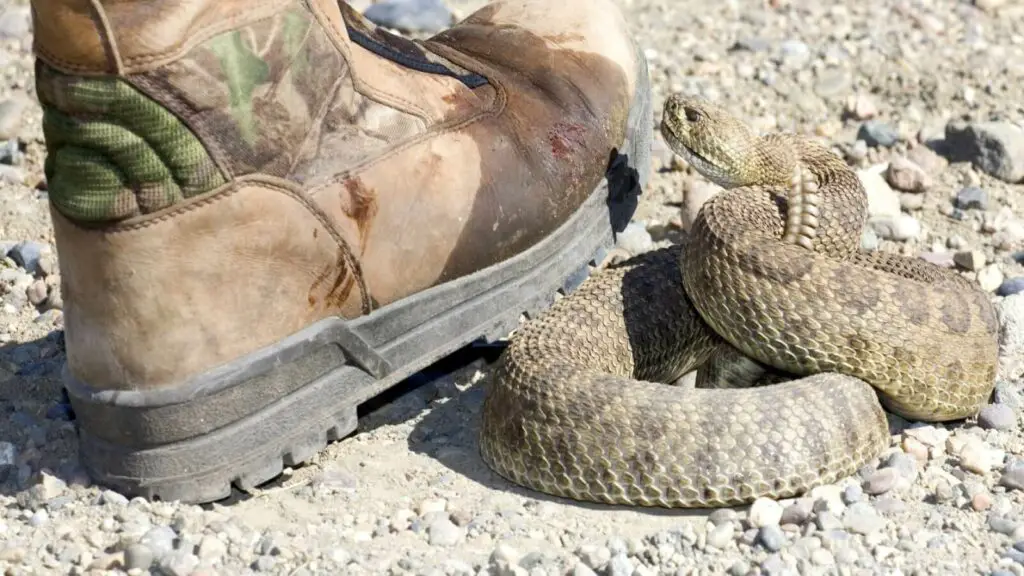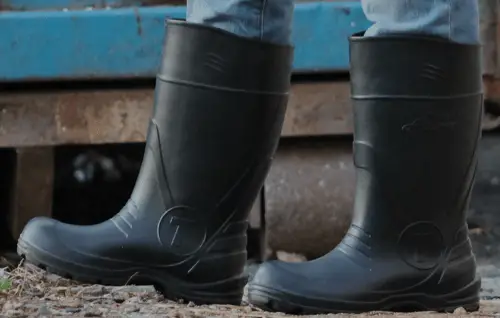If you are an avid hunter or outdoor enthusiast, you know the importance of having the proper safety gear when moving through brush, thickets, swamps and wetlands, grasslands, and rough terrains.
For those that often find themselves in environments that are in their natural state and uncultivated, one common risk is meeting up with a venomous snake.
Whether hidden under a log or behind a rock, natural primitive North American landscapes are home to numerous exemplars including copperheads, cottonmouths, coral snakes, and of course rattlesnakes.

When you least expect it, you may inadvertently disturb a snake that then strikes and bites you through boots or footwear.
Snakes, including venomous species, rarely bite humans and do so normally to defend themselves from what they perceive as danger. Dying from a snakebite happens rarely now in the United States thanks to excellent medical care.
Nonetheless, between 7,000 and 8,000 people are bitten annually by snakes, so when outdoors in the wild, snake boots may be a better choice than rubber boots.
| Snake Boots | Rubber Boots | |
|---|---|---|
| Safety | Integrated tight-weave, anti- puncture barrier | Can be found with steel toes and resistance to chemicals |
| Waterproofing | Yes | Yes |
| Boot Height | Mid-calf and knee height | Ankle, mid-calf, and knee height |
| Materials | Leather, denim, synthetic weaves, Cordura nylon, and Kevlar | Rubber, neoprene rubber, synthetic rubber |
| Comfort | Flexibility, air circulation, moisture-wicking innings, cushioned foot beds | Feature moisture-wicking linings, supportive midsoles and cushioned footbeds |
All About Snake Boots
Snake boots are specifically designed to protect feet and legs from snake bites that puncture clothing, footwear, and the skin with a pair of very sharp fangs.
Most snake bites will integrate into their design with a protective lining that will be produced in impenetrable materials that are still flexible for fit and comfort and create a barrier between your leg and foot and a snake.
If you regularly frequent areas where snakes are present, snake boots will offer good protection from the risks associated with these reptiles
What You Need in a Good Pair of Snake Boots
This type of footgear is designed to offer protection from a specific danger. But what are the protective features and qualities that snake boots should offer?
1.) Coverage
Snakes can puncture and penetrate like other hazards, but they are moving beings. They climb, crawl, and can attack when threatened or provoked, your feet and legs at any moment.
The more coverage a boot offers the better, so you should be looking for higher boots if visiting snake country. Boot uppers should reach at least mid-calf, and knee height will provide even more protection. Do not select boots that only arrive at the ankle.
Research suggests that most snake bites will affect the part of the leg that reaches from the ankle to the knee, so if you can find a pair that cover your legs to the knee, this will be a safer option.
Common boot shaft heights incorporated in snake boots range between 16 and 18 inches protecting both feet and calves, shins, and legs.

2.) Materials that Are Bite-Proof
Should you happen upon a snake in the woods or wetlands, you want to know that your footwear will protect you from that set of fangs, so the material used in boot construction is not only crucial but a priority.
Very few kinds of materials can offer this level of protection. In fact, materials used include leather, denim, synthetic weaves, Cordura nylon, and Kevlar.
Any combination of two or more of these materials in a tight weave makes fang penetration all but impossible. When selecting a pair of snake boots, look for these materials among construction components.
3.) Boot Closure Features
How your boots close on your legs will influence the level of protection that they provide. Zippers are the most common type of closure used in boots, but they can easily snag on bushes, branches, and vegetation in general.
If the snagging pulls the zipper open, your leg is then at higher risk for a snake bite, should one of these reptiles happen to be in the area.
Pull-on boots without an external closure are a viable and attractive alternative. Designs are simple and easy to maneuver, and these boots can be pulled on or off more rapidly.
They are a better solution than traditionally laced-up boots, but you need to select the right type for your intended activities.
Lace-up styles will offer the advantage of a more customizable fit but may present more difficulty in situations where you need to be able to put on or take off your boots rapidly.
Some snake boot designs may integrate more than one closure element, including extra elements like Velcro. The final choice of a closing mechanism will depend on your personal preferences.
4.) Breathability
Much too often, breathability and air ventilation inside a boot model are underestimated in terms of importance. Because you will be wearing a higher par of boots, increased perspiration is probable.
Increased perspiration will cause bacteria with resulting odors and general discomfort. For this reason, the insides of the boots merit consideration.
Boot linings should be moisture-wicking to keep feet dry while offering a minimum of space for air circulation and ventilation. This will be one of the principal challenges for snake boot manufacturers because these boots should also be waterproof.
5.) Proper Fit
While snake boot exteriors must be strong and tough to prevent fang penetration, comfort during wear is no less important. This is crucial if engaging in outdoor activities for a prolonged period.
Although you want the best possible external protection, you don’t want to be miserable during wear to the point that you end your activities early or find your movements restricted.
Look for sturdy boots that come with comfort features like flexibility in design and cushioned innersoles. Choose the right fit with the type of socks that you normally wear when engaged in outdoor or hunting activities. Discomfort is distracting, augmenting your risk factors.
6.) Waterproofing
A key feature of snake boots will be waterproofing. This is very important for hunters or those that wade through swamps, marshes, and wetlands. Some water snakes are venomous like water moccasins and just as dangerous as land snakes.
All About Rubber Boots
Rubber boots are designed with other purposes in mind and are specifically created to keep feet and socks dry when navigating wet surfaces, puddles, and in some cases streams or similar.
Many kinds of boots feature waterproofing from work boots to fishing waders, ski boots, and hunting boots.
Rubber boots are made from rubber and will not necessarily feature other materials. They are designed and produced specifically to protect feet and legs from water or muck.
They will not automatically offer other kinds of protection. These boots are a great option if you pursue activities in an area that is not a home to snakes, and specifically venomous snakes.
They will generally offer some type of ankle support and are suitable for outdoor and some work activities.

What Do You Need in a Good Pair of Rubber Boots?
1.) Material
Often rubber boots are produced with rubber that is blended with other components and molded into a specifically sized boot thanks to a process known as vulcanizing.
These single rubber unit constructions rarely feature any type of stitching, offering excellent waterproofing. Linings can provide offer warmth and cushion. Rubber is less flexible and does not offer breathability.
2.) Comfort
For all-day wear, comfort is a priority. While not optimal for hot climates, they can save the day in wet environments. The feet remain dry. Most rubber boot manufacturers offer cushioning and soft linings as well as insulation.
3.) Safety
While not produced to protect from snake bites, some may offer steel toes, supportive midsoles, and chemical-resistant material. Many will come in camouflage colors for hunting, and some feature odor-fighting materials.
4.) Style
Boot height can be decisive when purchasing. Tall boots, ankle boots, and calf-high rubber boots can be found with varying closure mechanisms.
5.) Fit
Sizing and how well the boots fit will prevent blisters and discomfort. Calf sizing for taller boots may also be a consideration.
FAQs
Can Snake Boots be punctured by snake fangs?
Some probably can be. The important thing to know when selecting a pair of snake boots is the snake species that are endemic to the area you will be frequenting and their biting and puncturing capabilities.
Can rubber boots be bitten through by snakes?
Rubber boots are not made to resist snake bites or even necessarily other kinds of punctures unless specifically designed as puncture resistant. Yes, snakes can puncture rubber boots.
Which boot is more expensive?
Snake boots are generally more expensive than rubber boots because they feature a tough exterior with snake puncture-proof material integrated into the design.
Which boot is best against water?
Rubber boots are designed to be waterproof and in some cases are molded from a single piece of rubber or rubber blended with other materials. Snake boots usually include a waterproof lining that has been sealed to keep feet dry.
In Conclusion: Are Snake Boots Better than Rubber Boots?
The answer to this depends on what environment you intend to wear them in. Both types of boots are valid and offer benefits. It depends on which benefits better suit your activities.
If you camp, hunt, fish, hike or reside in an area where snakes are known to live, you need specific snake bite protection.
Even if snakes rarely attack humans, when threatened or perceive to be threatened, they will strike defensively. If you accidentally step on one or surprise a snake, it will most likely react.
Do not underestimate the fact that snakes, especially in areas known to have snake populations, will hide, so you may not even notice one of these reptiles, and yet end up disturbing it.
Some snake bite victims realize they have upset one at the moment that it bites, and it’s a little late then. In these cases and conditions, proper snake boots offer credible protection.
Undoubtedly venomous snake bites are more dangerous and will do more damage, occasionally proving to be lethal. But even non-venomous bites can have you laid up for several weeks. Is it work the risk? No.
Snake boots will reduce the risks of both venomous and non-venomous bites out in the woods, desert, or while on the trail.
Both of these boots are great options depending on which kind of activities you plan to engage in during wear. Rubber boots will cost less but they will not offer any protection against snake bites.







